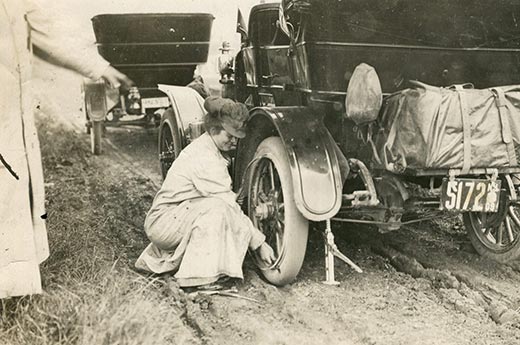"Women Drivers" In Period Advertising

Period advertising can be entertaining. The ads are often graphically interesting and it’s also kind of educational to read the copy. At the least they are historical artifacts, a window into the commercial mind of a different era. For the long Fourth of July holiday weekend we posted a piece on the Liberty Motor Car Company, including the above ad. It was published sometime between 1916 and 1923, when Liberty went out of business. While reading the ad copy, I came across the following phrase:
“How about safety, in these days of women drivers and crowded traffic? Did you ever see an emergency brake applied with a touch of one finger that will stop a car without shock at full speed – surely – smoothly – safely. Try the Liberty emergency – and try it where life might depend on its action.“
At first my reaction was “women drivers”?
Then I thought, maybe the reference to women drivers was not disparaging but rather appealing to protective impulses. That’s a theme common in a lot of recent commercials, and some not so recent. There’s the Subaru ad with the dad talking to a little girl playing behind the wheel of their car sitting in their driveway who turns into a 16 year old about to drive on her own for the first time.
Michelin has been using the tagline Because so much is riding on your tires since 1985, when the DDB ad agency created this ad. It’s been called one of the most effective advertising slogans ever and it’s all based on appealing to parents’ protective natures.
Interestingly, this 1987 version shows the changing roles of women, because it’s the mother, not the father who is buying Michelins so their child will be safe.
I’ve written about the incessant cliched and misandrist stupid father commercials, so this Chevy truck commercial, with Tim Allen sonorous tagline “the things you carry are even heavier than the things you haul”, also a variation on the “keep my family safe” theme, hits all the right notes for me. It shows a capable, caring and strong but gentle dad dropping his kid off to day care on the way to work.
That’s why I thought it was silly when this old Goodyear ad was labeled as sexist. It’s just another variation on the same theme. Yes, back then men may have made most tire purchases, but if it was okay for a mother to be concerned about her daughter’s safety in 1987, it was okay for a husband to be concerned about his wife’s safety in 1967. Besides, unlike all those stupid dad commercials, it shows the wife actually accomplishing her task, getting to the airport in difficult traffic conditions, picking her husband up. I think what really bothered the scolds was that when she picked him up, she slid over and let him get behind the wheel, the ad ending with a kiss. I’m guessing that they could reshoot the same commercial today, not changing a thing other than making it a same-sex couple, and the same folks who call the old ad sexist would cheer it.
People were concerned about their families’ safety in 1917 as well. Perhaps rather than mocking women drivers, maybe the Liberty ad was appealing to them and their husbands. I’m not so sure that it’s putting down women as much as trying to sell the car to women and to husbands of “women drivers”, concerned for their safety in increasingly crowded traffic.
Alice Ramsey changing a tire on her renowned 1909 cross-country drive.
To be honest, I’m not even sure if “woman driver” had become a pejorative by the time the ad was published. Liberty was in business from 1916 to 1923. It was a time of women’s suffrage. Women drivers like Alice Ramsey and Dorothy Levitt (who held land and water speed records and wrote what is probably the only book that gives both fashion advice and instructions on how to rebuild a carburetor) were world-famous years before the Liberty was on sale. By the time the Liberty was being made, Kettering (another one of those “dead white males” whose inventions helped liberate women) had developed the electric starter and women drivers were indeed becoming more common.
Dorothy Levitt at the inaugural Brighton trials, 1905
One of the Liberty’s selling features was ergonomics, the ad mentions how just a “touch” is needed at the controls. Note how the text that I’ve quoted says that with “touch of one finger” on the emergency brake the car can be brought to a complete halt safely (presumably to avoid an accident). Perhaps all that ergonomics and light touch was a selling point to women, implying that a driver didn’t need a man’s physical strength to drive the Liberty.
Dorothy Levitt in a Napier racer at Brooklands in 1908
I’m not naive, and neither was whoever wrote the copy for this ad. Read it. It’s pretty sophisticated copy for an ad from not very long after Alfred Lasker more or less invented modern advertising. It’s possible Liberty was trying to have it both ways. They use the phrase “women drivers” but they don’t actually say anything disparaging. Maybe novelist L.P. Hartley’s famous opening line, “The past is a foreign country; they do things differently there,” applies. Maybe it really was patronizing and sexist, but I’ve seen enough period advertisements from that era that were pitching cars and car accessories to women to think that Liberty was perhaps being true to its name and was as eager to make money off of women drivers as it was from men.
Ronnie Schreiber edits Cars In Depth, a realistic perspective on cars & car culture and the original 3D car site. If you found this post worthwhile, you can dig deeper at Cars In Depth. If the 3D thing freaks you out, don’t worry, all the photo and video players in use at the site have mono options. Thanks for reading – RJS

Ronnie Schreiber edits Cars In Depth, the original 3D car site.
More by Ronnie Schreiber
Latest Car Reviews
Read moreLatest Product Reviews
Read moreRecent Comments
- SCE to AUX Over the last 15 years and half a dozen vehicles, my Hyundais and Kias have been pretty cheap to maintain and insure - gas, hybrid, and electric.I hate buying tires - whose cost goes by diameter - and I'm dreading the purchase of new 19s for the Santa Fe.I also have an 08 Rabbit in my fleet, which is not cheap to fix.But I do my own wrenching, so that's the biggest factor.
- MaintenanceCosts '19 Chevy Bolt: Next to nothing. A 12v battery and a couple cabin air filters. $400 over five years.'16 Highlander Hybrid, bought in 2019: A new set of brakes at all four corners, a new PCV valve, several oil changes, and two new 12v batteries (to be fair, the second one wasn't the car's fault - I had the misfortune of leaving it for a month with both third-row interior lights stealthily turned on by my kid). Total costs around $2500 over five years. Coming due: tires.'11 BMW 335i, bought in late 2022: A new HID low beam bulb (requiring removal of the front fascia, which I paid to have done), a new set of spark plugs, replacements for several flaking soft-touch parts, and two oil changes. Total costs around $1600 over a year and a half. Coming due: front main seal (slow leak).'95 Acura Legend, bought in 2015: Almost complete steering and suspension overhauls, timing belt and water pump, new rear brakes, new wheels and tires, new radiator, new coolant hoses throughout, new valve cover gaskets, new PS hoses, new EGR valve assembly, new power antenna, professional paint correction, and quite a few oil changes. Total costs around $12k over nine years. Coming due: timing belt (again), front diff seal.
- SCE to AUX Given this choice - I'd take the Honda Civic Sport Hatchback (CVT). I 'built' mine for $28777.To my eye, the Civic beats the Corolla on looks these days.But for the same money, I can get an Elantra N-Line with 7-speed DCT, 201 HP, and good fuel economy, so I'd rather go for that.
- Kwik_Shift_Pro4X '19 Frontier Pro 4X. Next to nothing. All oil changes are on schedule. Got new tires at 60000 miles. Still on original brakes at 79000 miles. Those are due soon. Brakes complete estimate $1000 all in.
- Dr.Nick The cars seem really expensive with tight back seats and Cadillac was on the list of the highest price gouging dealers coming out of COVID. I don’t understand the combination, shouldn’t they be offering deals if they are not selling?


































Comments
Join the conversation
You think old timey auto ads were sexist? You have no idea. "Ladies, are you wondering why your husbands have lost interest? Yes, that's right. That fish smell isn't last night's flounder dinner." http://alwayssick.com/wp-content/uploads/2010/12/lysol-douche-ad1.png
Cars were already marketed to women at the time too, in opposition to bicycles. In a car a lady in her dress and makeup could stay fresh, clean, and relaxed while her counterpart on a bike was mannish, sweaty, wearing trousers, an old maid without a man to support her, possibly a lesbian, possibly enjoying the ride too much wink wink. Just think of Elmyra Gulch in The Wizard of Oz if you need an archetype.